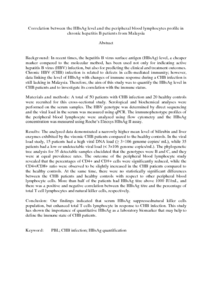Citation
Hadi, Qabas Neamah and Mustafa, Mohammed Imad Al-Deen and Jaafar, KhairulAzhar and Hui, Yee Chee
(2016)
Correlation between the HBsAg level and the peripheral blood lymphocytes profile in chronic hepatitis B patients from Malaysia.
Journal of Virology and Antiviral Research, 5 (2).
pp. 1-7.
ISSN 2324-8955
Abstract
Background: In recent times, the hepatitis B virus surface antigen (HBsAg) level, a cheaper marker compared to the molecular method, has been used not only for indicating active hepatitis B virus (HBV) infection, but also for predicting the clinical and treatment outcomes. Chronic HBV (CHB) infection is related to defects in cells-mediated immunity; however, data linking the level of HBsAg with changes of immune response during a CHB infection is still lacking in Malaysia. Therefore, the aim of this study was to quantify the HBsAg level in CHB patients and to investigate its correlation with the immune status.
Materials and methods: A total of 50 patients with CHB infection and 20 healthy controls were recruited for this cross-sectional study. Serological and biochemical analyses were performed on the serum samples. The HBV genotype was determined by direct sequencing and the viral load in the serum was measured using qPCR. The immunophenotype profiles of the peripheral blood lymphocyte were analyzed using flow cytometry and the HBsAg concentration was measured using Roche’s Elecsys HBsAg II assay.
Results: The analyzed data demonstrated a narrowly higher mean level of bilirubin and liver enzymes exhibited by the viremic CHB patients compared to the healthy controls. In the viral load study, 15 patients had a high viral DNA load (≥ 3×106 genome copies/ mL), while 35 patients had a low or undetectable viral load (< 3×106 genome copies/mL). The phylogenetic tree analysis for 35 detectable samples elucidated that the genotypes were B and C, and they were at equal prevalence rates. The outcome of the peripheral blood lymphocyte study revealed that the percentages of CD4+ and CD8+ cells were significantly reduced, while the CD4+/CD8+ ratio were observed to be slightly increased in the CHB patients compared to the healthy controls. At the same time, there were no statistically significant differences between the CHB patients and healthy controls with respect to other peripheral blood lymphocyte cells. More than half of the patients had HBsAg titre above 1000 IU/mL, and there was a positive and negative correlation between the HBsAg titre and the percentage of total T cell lymphocytes and natural killer cells, respectively.
Conclusion: Our findings indicated that serum HBsAg suppressednatural killer cells population, but enhanced total T cells lymphocyte in response to CHB infection. This study has shown the importance of quantitative HBsAg as a laboratory biomarker that may help to define the immune state of CHB patients.
Download File
![[img]](http://psasir.upm.edu.my/55391/1.hassmallThumbnailVersion/Correlation%20between%20the%20HBsAg%20level%20and%20the%20peripheral%20blood%20lymphocytes%20profile%20in%20.pdf)  Preview |
|
PDF (Abstract)
Correlation between the HBsAg level and the peripheral blood lymphocytes profile in .pdf
Download (110kB)
| Preview
|
|
Additional Metadata
Actions (login required)
 |
View Item |

